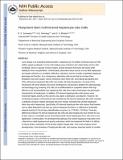Pluripotent stem cell-derived hepatocyte-like cells
Author(s)
Schwartz, Robert E.; Khetani, Salman R.; Fleming, Heather; Bhatia, Sangeeta N
DownloadBhatia_Pluripotent stem.pdf (186.8Kb)
PUBLISHER_CC
Publisher with Creative Commons License
Creative Commons Attribution
Terms of use
Metadata
Show full item recordAbstract
Liver disease is an important clinical problem, impacting over 30 million Americans and over 600 million people worldwide. It is the 12th leading cause of death in the United States and the 16th worldwide. Due to a paucity of donor organs, several thousand Americans die yearly while waiting for liver transplantation. Unfortunately, alternative tissue sources such as fetal hepatocytes and hepatic cell lines are unreliable, difficult to reproduce, and do not fully recapitulate hepatocyte phenotype and functions. As a consequence, alternative cell sources that do not have these limitations have been sought. Human embryonic stem (hES) cell- and induced pluripotent stem (iPS) cell-derived hepatocyte-like cells may enable cell based therapeutics, the study of the mechanisms of human disease and human development, and provide a platform for screening the efficacy and toxicity of pharmaceuticals. iPS cells can be differentiated in a step-wise fashion with high efficiency and reproducibility into hepatocyte-like cells that exhibit morphologic and phenotypic characteristics of hepatocytes. In addition, iPS-derived hepatocyte-like cells (iHLCs) possess some functional hepatic activity as they secrete urea, alpha-1-antitrypsin, and albumin. However, the combined phenotypic and functional traits exhibited by iHLCs resemble a relatively immature hepatic phenotype that more closely resembles that of fetal hepatocytes rather than adult hepatocytes. Specifically, iHLCs express fetal markers such as alpha-fetoprotein and lack key mature hepatocyte functions, as reflected by drastically reduced activity (~ 0.1%) of important detoxification enzymes (i.e. CYP2A6, CYP3A4). These key differences between iHLCs and primary adult human hepatocytes have limited the use of stem cells as a renewable source of functional adult hepatocytes for in vitro and in vivo applications. Unfortunately, the developmental pathways that control hepatocyte maturation from a fetal into an adult hepatocyte are poorly understood, which has hampered the field in its efforts to induce further maturation of iPS-derived hepatic lineage cells. This review analyzes recent developments in the derivation of hepatocyte-like cells, and proposes important points to consider and assays to perform during their characterization. In the future, we envision that iHLCs will be used as in vitro models of human disease, and in the longer term, provide an alternative cell source for drug testing and clinical therapy.
Date issued
2014-01Department
Harvard University--MIT Division of Health Sciences and Technology; Massachusetts Institute of Technology. Department of Electrical Engineering and Computer Science; Koch Institute for Integrative Cancer Research at MITJournal
Biotechnology Advances
Publisher
Elsevier
Citation
Schwartz, R.E., H.E. Fleming, S.R. Khetani, and S.N. Bhatia. “Pluripotent Stem Cell-Derived Hepatocyte-Like Cells.” Biotechnology Advances 32, no. 2 (March 2014): 504–513.
Version: Author's final manuscript
ISSN
07349750